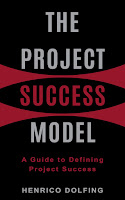Project success and project failure are NOT absolutes.
It may not be possible to be a little bit pregnant, but you can be a little bit successful.
Every project has multiple success criteria related to business results, product/service results, and project delivery results (cost, schedule, scope, and quality).
Some criteria are absolute, meaning they must be completed on or before the original planned date, and some are relative, meaning they must be completed by a date acceptable to the client.
Project success is determined by how many of your success criteria are satisfied, and how well.
Who do you ask?
Whether or not a project is successful also depends on who you ask:
> The very happy project manager that implemented the SAP project as scoped on time and below budget (I know, this will NEVER happen).
> The end users who absolutely hate the complexity and slowness of the new system.
> The COO that has seen IT costs double whilst none of the expected savings materialized.
They may all have very different opinions on the success of the project.
When do you ask?
Project success also depends on when you ask.
Twelve months after the go-live, the users will have a better grasp of the system and initial performance problems will have been solved. And slowly but steadily, the expected savings will often start to materialize as well.
So in order to determine the success or failure of your project, you should define all the criteria relevant to your project, define how you will measure them, and define when you will measure them.
What level you look at?
Simply put, project success occurs when the outcome of the project adds value to the organization. And the value of a project is defined by subtracting all of the costs from all of the benefits the project delivers.
Value = Benefits - Costs
This can be roughly translated to three levels of project success:
1) Project delivery success: Will the project delivery be successful? Essentially, this assesses the classic triangle of scope, time, and budget. These are your costs.
2) Product or service success: This refers to when the product or service is deemed successful (e.g., the system is used by all users in scope, up-time is 99.99 percent, customer satisfaction has increased by 25 percent, and operational costs have decreased by 15 percent). These are your benefits.
3) Business success: This has to do with whether the product or service brings value to the overall organization, and how it contributes financially and/or strategically to the business’s success. This is your value.
Overall, a successful project depends on the combination of these criteria.



